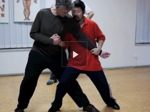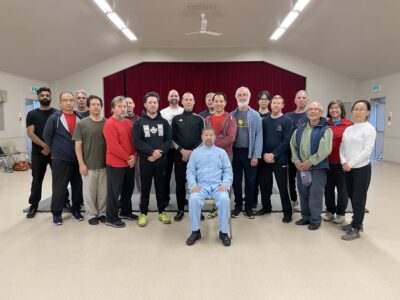
Ben Phillips of Toronto became Chen Zhonghua’s 379th disciple in a brief ceremony at the Annual Toronto Practical Method Seminar
This is the first Toronto Practical Method workshop by Master Chen Zhonghua since covid-19 started. We had a very good turnout, 25 people attended over the 4 days of the workshop. Participants came from Toronto, Markham, Aurora, Newmarket, Oakville, Georgetown, Ottawa, Michigan, Iowa, Arizona, California. One of the participants commented:
“Everyone here expressed and interacted freely and deeply, just like a big family.”
In this workshop, we focussed on training with drills, solo and partnered. The drills allowed us to develop gong, and techniques that would be useful in push hands. Many of the drills were video-recorded and will be available for purchase. We also included one lesson of Hunyuan Qi Gong, and Master Chen said he would begin to integrate more energy work into Practical Method through some Hunyuan Qi Gong training.
The following were intended to remind myself of what happened at the workshop, and they were not to be instructional. However, if you have any questions and need clarification for any part, please feel free to make a comment below.
Day 0
Power or No power?
Master Chen Zhonghua said if you knew how to use the kua, then you would need to power up with your arms. People already have power would be difficult to give that up.
The first exercise he showed me this time was that I put my kua in certain place after I got in with the hand not moving. I had to maintain a certain gear relationship between the hand and kua at the shoulder. When I felt like I locked my hand to the torso, the mistake was that I powered up/got stuck at my shoulder. In order to do the move successfully, I needed to:
Drop my shoulder while not moving the hand
Open my kua and rotate my waist
Dropping the shoulder and not moving the hand was the idea of a lever in actual action. The problem I faced with this move was that every time Master Chen said I did it right, it was like there was no resistance. I would think that he just let me do it. My mind would say that I would need to use more power (meaning push harder) if someone resisted harder. However, that would be totally wrong.
The conflict comes when I trained solo I used a lot of effort in put myself within a shell. It felt like I had to use a lot of power. Based on other previous experience, the right move would be make me feel unbelievably easy and light, and it did not mean the opponent wouldn’t feel the power, but I wouldn’t feel it and I was constantly looking for it unconsciously.
Day 1
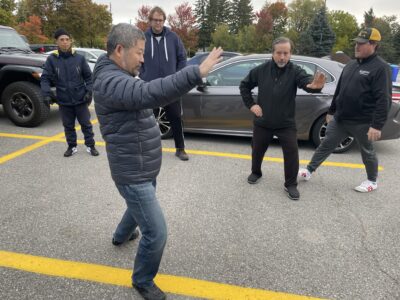
Moving Step Positive Circle – See workshop video with Lou Sacharske reviewing this lesson.
- Maintain the distance/stick between the front hand and the dantien
- During moving step, make sure that there is no tilting back and forth at the waist. The waist should be maintained parallel to the ground.
- With a partner providing resistence, step forward without losing the upper body shape.
- Maintain a line/rod/axis between the middle finger tip and the shoulder. Rotate on this line with the elbow going from one side to the other.
- Make the elbow go from one side to the other, but this time with the focus on maintaining the distiance between the elbow and the previous axis
Six Sealing Four Closing
- Pull the person in with a “lu”, and then send the person away by going over the shoulder and pull the foot backwards. The shoulder has to go lower as well.
- In the future, the rear foot does not even need to go backwards, and the rear keel does not need to be lifted and pressed downwards, however, the act of pushing the rear heel/foot against the ground is still needed, but there is no movement of the foot itself.
White Crane Spreads Its Wings
- Start with putting my right forearm on the opponent’s chest. Rotate left with my waist with no upper movement until limit. Right hand not moving, my right shoulder goes down, my right foot goes backwards causing the right to extend forward. When the extension is done, bring my right elbow and left elbow together to squeeze the energy towards my right hand.
Unbendable Arm
- The opponent tries to bend my arm with two hands at the elbow pressing downwards. At the moment that he presses downward, the energy on the elbow needs to be transmitted to the finger tips on his shoulder by squeezing him with the fingers. The effect is that he is pressing down on his own shoulders through my arm. The common mistake is to push my elbow directlly against the downward force.
- On the other hand to break the unbendable arm, open my armpit backwards, rotate my shoulder where the opponent’s hand is on over the top and send the energy towards the bendable crease of the elbow. If the opponent does not bend the arm, keep my eye on the opponent’s shoulder, use the opponent’s arm as the handle to manipulate other parts of the body instead.
Cut hand on the opponent’s forearm requires a little rotation at the contact point. This is a common demo by Master Chen. The principle is that when you have a linear movement, you need a rotation at the end. When you rotate, you need to find the straight line. This is hard to explain, this has very much to do with energy flow.
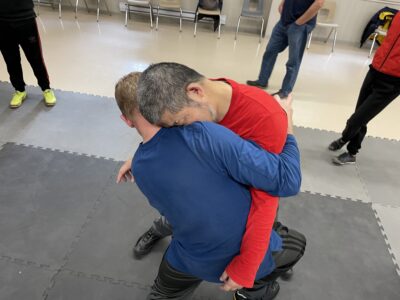
Sleeping exercise
- One person just pretends to be heavy against the opponent, and just lies on him. No fighting, only matching and adjusting.
Exercise: Control the opponent’s middle of the chest
- Grab the opponent’s two wrists
- Stretch them out to lock the opponent’s upper body at the middle of his chest.
- For someone like Harshil, it needed a different way to lock his chest. I needed to bring his two wrists together and rotate his arms to send the energy towards the middle of his chest.
Day 2
Positive Circle
- In with elbow, turn the kua, out with hand. Separate the movements.
- The turn with kua needs to carry the elbow, and not just rotate the shoulder.
- The kua rotation needs to match up with the opening of the elbow.
Negative Circle
- 3 parts in the first step
- Rotate the waist back to the front while arm goes down. The two actions need to be done independently but at the same time.
- Extend the hand
Rotation Exercise
- Arm on opponent’s chest
- Lock the arm to my torso
- Rotate my torso
He showed the maintenance of the dot in a section of yilu. See one of the videos for this workshop.
Train the positive with the dot in space. Use the right hand as the reference at the circumference of the circle. Maintain the same radius between the right hand and the dot in space. Do not move the right hand, but use the rest of the body to draw this circle.
Six sealing four closing to lock the opponent, then move my rear foot backward to “lu” the opponent. Step the front foot, extend the arms to send the opponent away.
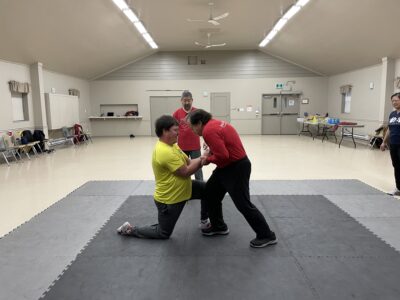
Shun Chan/Ni Chan
Stepping Drill – See one of workshop videos.
Drill into another person exercise (coined marriage proposal)
- I push into the opponent’s kneeling down with one knee diagonally.
- Hold that power.
- Shun Chan: Get in and under where I am touching the opponent with my hands
- Ni Chan: Extend the arm diagonally to push the opponent down
Two stage punch (tank penetrating missile)
- 1st Stage: Touch the opponent with the fist as a normal punch
- 2nd Stage: Send the energy from dantian to the fist.
Unbendable Arm Part 2
- Stretch one part of my armpit backward and then lock, move another body part. Keep aim at the opponent’s shoulder.
- Lock the opponent’s shoulder, and my shoulder. Send the energy back to opponent’s elbow to bend it.
Master Chen showed drilling in the limbs doing the yilu.
Shun is He (close) and Ni is Kai (open)
Exercise: Get in with shun, push out with ni
Initial closing drill
- Pull with elbow in, out with hand to send the opponent away
Impale with six sealing four closing
- Use the rear foot step down to lead incoming energy to the ground.
How to not let the opponent rotate and spin me out? (Training with Levi)
- Stick with him
- Don’t allow space between opponent and myself
- Maintain control of the 4 corners (2 shoulder and 2 kuas)
- There has to be a dot in me that does not move, I stretch anywhere else other than the dot.
- This trains sensitivity.
For the linear motion, regardless of whether I rotate or not, the body part that makes the linear motion must maintain the striaghten line towards the original destination. To send the opponent, step forward. To maintain the bie on the arm, use the front and rear hand. To rotate horizontally, use the waist/kua.
Exercise: Maintain the line
- Grab the opponent at the two wrists
- Pull along the opponent’s arms and extend that line all the way to the ground
- We have to include a rotation in the middle to get out of the way while keeping the opponent on the ground.
Exercise: Pull the opponent down and bump him to the floor.
- Grab the opponent at the two wrists
- Pull along the opponent’s arms, there must be a jerk (cai) to get the opponent off balance
- Step in and go down myself.
- Bump the opponent at the shoulder, but send the energy to the opponent’s kua along the line that will tilt him backwards.
Typical Chen Style Taijiquan exercise
- The two people stand with a different front foot.
- My right hand holds the opponent’s right hand.
- My left hand holds the opponent’s left hand.
- The right hand in front person tries do a negative circle to get the opponent down.
- The left hand in front person tries to bie the opponent’s right arm.
Exercise: Six Sealing Four Closing
- As the opponent bends my front shoulder down, I lock my front hand, and rotate on my front shoulder downwards, and sends the energy straight down to cut the opponent.
No push!!! Yes, really no push.
- I had a really weird and importance experience this time. How many times have we heard that there is no push?
- Chris Martinez is pushing hands against Master Chen, and I was standing behind Chris.
- Master Chen didn’t send Chris towards my direction, but instead Chris left me in a perpendicular angle.
- I was expecting to feel something, but I felt nothing. Chris just went out 3 feet.
- In the same setup for the 2nd time, I placed my hand on Chris’ right shoulder, Master Chen placed his left hand on top of Chris’ right shoulder. Chris went out in the exact same way, but I felt absoluting no push/pressure from Master Chen’s left hand, and yet Chris’ big body went out like being carried in a river. The energy was so much that enveloped Chris’ entire body.
Day 3
At the Push Hands Zoom class:
Exercise: Thrust the kua exercise
- Lock the shoulder and front knee, move the kua forwards towards the opponent’s down dantian.
- Lock two ends, move the middle.
- The energy needs to go from bottom around the shoulder.
- Flipping the triangle from one side two the other.
- My back was not straight. I need to stretch the mingmen backwards more.
Tan Dou – Shaking power
- Small rotation to find the straight line to send the energy out
Front Trick/Rear Trick
- Only move the lower hand on the straight line, without moving upper hand.
- Even if you add a waist rotation, the lower hand will continue to move on the same without following the rotation.
At the workshop:
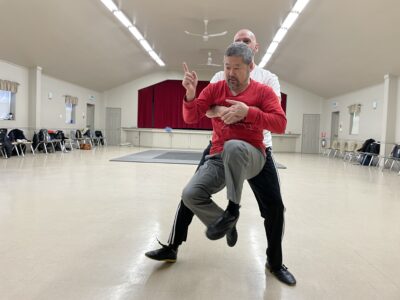
Acceleration exercise
- Like using hand to accelerate a spinning wheel
- The top maintains the lock.
- The bottom using a small set of small steps to accelerate.
- We want different rhythm between the top and the bottom.
- The bottom sends the energy to the finger tip to drive the car forward.
Pigtail exercise (Rubber band at the waist exercise)
- Tie a rubber cord around the waist.
- Rotate the body to make the rubber cord flys up and go around you, Rotate horizontally in alternating direction to keep the rubber band flying up.
- Move your feet without stopping the waist rotation (rubber band does not come down).
Exercise: Thrust the kua
- Lock forehand and knee
- Stretch the front part of the thigh
- Throw the kua forward such that I will throw my whole body forward.
- Understand that thrust and make sure that other parts not moving.
- The kua needs to do a 挖 against the shoulder.
Exercise: Line up the front hand and dot on the back.
- The fingers need to stretch up and account for projectile.
Exercise: Six Sealing Four Closing
- When two hands move away from each other, there is a dot in the middle on the track.
- Train fajin. The rear elbow needs to find the rear foot.
Taiji is a function.
Hu Xi exercise
- Hu: Breathe-out
- Xi: Breathe-in
- Repeat 16 count of Xi, 1 count of Hu
- Lie down to test if you are morning or night person.
- After you do this, if you are sleeping, you are night person, then do it when you go to bed
- No color, no smell/taste
- Training vs Practice
- Practice is the one that tests if you are morning or night person.
- Training is to do it for real
- Chest out, dantian in, then chest in, dantian out.
- Knee/foot out, dantian in, then knee/foot in, dantian out
- This is sending the energy to different places.
- There is no active breathing, we move the body part in such a way that the air comes in and out due to pressure differences.
Hunyuan Qi Gong
- Upper Dantian – Head area
- Middle Dantian – Stomach area
- Lower Dantian – Groin area
- Left hand on top of the right hand.
- Put the hands on the middle dantian.
- With the right hand index finger knuckle poking the the left hand’s lao gong xue. Lao gong xue is the spot on the palm after you bend your middle finger, where the middle finger tip touches.
- Close the eyes, and see what kind of fire you see.
Exercise:
- Throwing energy from dantian to the fist.
- Key is to stop the fist from moving.
Exercise: Catch a fly
- Throw the hand out to catch the fly, and quickly without stopping, do elbow-in.
Exercise: Avoid a bunch and bump the opponent
- To deal with a punch to the face:
- We go down and do a side step at the same time.
- Then we move with a big step towards the opponent.
- Use a kao to hit the opponent.
Day 4
Exercise: Pull the arm with a jerk
Exercise 1:
- Pull the hand on the opponent’s elbow
- Glide down to catch the opponent’s wrist at the bone, use only middle finger and thumb.
- Add a jerk (cai) at the end.
- Stand with opposite feet as the front foot, so that there is a twist in one position of this exercise.
Exercise 2:
- Same as above, but put the left hand on the opponent’s elbow as the jerk happens.
Exercise 3:
- Do exercise 2 smoothly.
- I am standing with my right foot in front.
- As my hand goes to oppoonent’s stomach with my palm facing that stomach, at the end, turn over (in a positive circle way) to catch the opponent at his wrist, and turn him over. My left hand will touch his right elbow.
- When the jerk happens, I bend my knees to match that, so no jerk is felt.
Exercise:
- Arm as handle, spin using shoulder vertical axis
- Once you see the vertical axis, you can use different ways to rotate on it, such as the right arm out move in the Buddha’s Warrior Attendant Pound Mortar
Exercise: Kua exercise
- Two people sitting in chairs facing each other.
- One person providing resistence with two knees on the outside, and one person training to open the kua with his knees between the two knees of the opponent. To open, we need to shoot outward from the belly button towards the opponent’s spine and beyond.
- We also train to close the opponent’s thighs by stretching over the opponent’s knees.
Lever
- It is easy to have a long power arm to move the load on the short end of the lever.
- We need to train to be able to move the load on the long end of the lever.
- Eventually, we need to train to make the pivot/anchor in space, at that time, the opponent would not be able to stop our action.
- Put my right/front arm in front of the opponent’s stomach.
- Lock the right index finger tip, and my right shoulder.
- Rotate my right elbow aroundn the axis between my right index finger tip and right shoulder.
Day 5 (Private)
Peng Lu Ji On – Bounce (Outside of a tire)
Cai, Lie, Zhou, Kao – Broken (Inside of a tire, blender, can’t get out)
Hand to foot stick exercise
Touch the opponent with the entire palm at the chest, then stretch the fingers against the locked root of the palm. Common mistake is that the root of the palm leaves the chest as we attempt to stretch the fingers, when this happens, there is actually no stretch. We also need to practice this as in motion, meaning that we walk up to the opponent without pushing him, and then stretching the fingers.
Right palm and elbow on the opponent chest, left foot behind the opponent’s right (front) leg. drop the right shoulder to extend the right hand without moving the right hand, at the end of the stretch, add horizontal rotation, then right elbow needs to find the left kua to remove space. Right elbow moves in 1 unit, the left kua needs to move in 5 units. The key is that the bigger action is from the bottom and inside. The result is that the rotation starts from the inside, and radiates out, and the opponent is not allowed to get away (like inside a blender).
Exercise:
- Get in to the opponent, so close with the feet almost together. It is a very uncomfortable position.
- This requires a squeeze to cause the opponent to respond.
- Step-in in such a way that my energy is aiming at the middle of the opponent at a perpendincular angle (A simplified version is to step between the two feet of the opponent).
- Put your hand(s) on the opponent’s torso in a place that there is a catch, like at the bottom of his ribs.
- Extend from the foot, up the front of the thighs, dantian, chest, armpit, to the arms to get the opponent up in the air, and then stretch the fingers to send him out.
Open vs Close
- It is the two sides of the same thing.
- Master Chen demonstrated a move that he caved in his chest (close) vs he stretched his back (open).
- Another example is stretching the outside of the forearm or the inside of the forearm.
Exercise: Rotating Arm
- If the opponent locks up his structure to block your rotation of the arm, open the armpit to extend the arm, and quickly rotate the armpit to change the direction before the opponent locks up again.
Exercise: Elbow vs Hand
- Poke the hand and forearm forward towards the opponent.
- Elbow, Elbow, Hand
- Hand, Hand, Elbow
- Untrained people can’t tell which one is used, as externally they look the same.
Note: Elbow can mean using the whole body in this case.
Major take-away points for myself from this workshop:
- Maintain the opponent on the line in any pull to the ground.
- Sufficient speed is needed to rotate, like how we spin a top. If you pull the opponent, and it is not fast enough, his feet move at the same speed as the torso, there is no tilt (vertical rotation).
- At the end of the stretch, rotate slightly to get the energy to go over.
- Match the opponent’s intended action on one of my body part using a different body part. He pushes my chest, I stretch my fingers towards his central line without reacting at the chest. This allows the opponent’s energy to be sent back to him.
- In order for the energy to be separated from my body in an action, I need to produce a stop.
- Exhaust one body part’s action, hold it, continue with another body part action. When the 2nd part is exhausted, the first part may continue, or a 3rd part is needed.
- Squeeze in to draw a response from the opponent, so that I can have a catch on the opponent.
- The bottom action must be bigger than the top, although this may not be seen by others.
Breakthrough
This workshop was a significant milestone for myself. I could see Master Chen’s lines, body actions, and energy flows. It felt wonderful that he would take a quick look at my action for a drill and give a nod, then move on to another person. If I didn’t do it quite completely to his satisfaction, after he gave a couple of pointers, I would be able to do it for the drill. This was the workshop that I got the most number of “this is it” from him. This provided motivation to keep on training. My next step would be able to apply these new techniques in free push hands.


